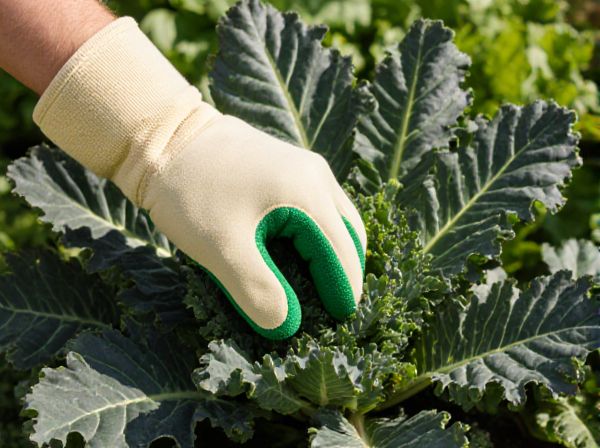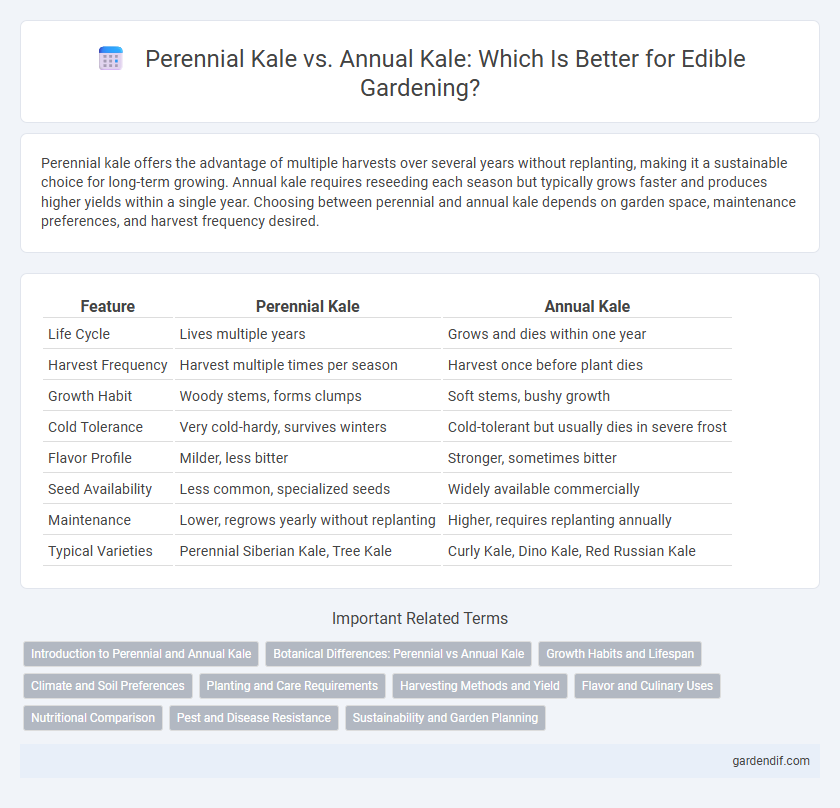
Perennial Kale vs Annual Kale Illustration
Perennial kale offers the advantage of multiple harvests over several years without replanting, making it a sustainable choice for long-term growing. Annual kale requires reseeding each season but typically grows faster and produces higher yields within a single year. Choosing between perennial and annual kale depends on garden space, maintenance preferences, and harvest frequency desired.
Table of Comparison
| Feature | Perennial Kale | Annual Kale |
|---|---|---|
| Life Cycle | Lives multiple years | Grows and dies within one year |
| Harvest Frequency | Harvest multiple times per season | Harvest once before plant dies |
| Growth Habit | Woody stems, forms clumps | Soft stems, bushy growth |
| Cold Tolerance | Very cold-hardy, survives winters | Cold-tolerant but usually dies in severe frost |
| Flavor Profile | Milder, less bitter | Stronger, sometimes bitter |
| Seed Availability | Less common, specialized seeds | Widely available commercially |
| Maintenance | Lower, regrows yearly without replanting | Higher, requires replanting annually |
| Typical Varieties | Perennial Siberian Kale, Tree Kale | Curly Kale, Dino Kale, Red Russian Kale |
Introduction to Perennial and Annual Kale
Perennial kale, such as tree kale or sea kale, grows for multiple years, offering continuous harvest without the need for replanting each season, which enhances sustainability and reduces labor. Annual kale completes its life cycle within one growing season, requiring planting every year and providing a quicker, more predictable yield suitable for seasonal gardens. Understanding the growth habits and maintenance requirements of both perennial and annual kale is essential for optimizing edible garden productivity and long-term greens supply.
Botanical Differences: Perennial vs Annual Kale
Perennial kale (Brassica oleracea var. ramosa) differs from annual kale (Brassica oleracea var. acephala) primarily in its life cycle, with perennial kale living for multiple years and annual kale completing its growth in a single season. Botanically, perennial kale develops a woody stem and deeper root system enabling survival through winters, while annual kale remains herbaceous with a softer stem and relies on seed production to propagate each year. These differences influence cultivation practices, where perennial kale offers long-term harvests and annual kale requires replanting each season.
Growth Habits and Lifespan
Perennial kale, such as tree kale or walking stick kale, exhibits a long lifespan, often living and producing leaves for several years, with a woody base that continues to grow season after season. In contrast, annual kale completes its life cycle within one growing season, requiring replanting each year, but it typically grows faster and produces a larger harvest in a shorter time frame. The hardy growth habit of perennial kale makes it suitable for sustainable food production, while annual kale offers rapid turnover for fresh greens.
Climate and Soil Preferences
Perennial kale thrives in mild, frost-tolerant climates and prefers well-drained, loamy soil with consistent moisture, making it ideal for regions with moderate temperatures. Annual kale grows best in cooler climates with temperatures between 60-75degF and favors fertile, well-drained soil rich in organic matter for rapid growth. Both varieties benefit from soil pH levels ranging from 6.0 to 7.5, but perennial kale demonstrates greater resilience to variable soil conditions and seasonal shifts.
Planting and Care Requirements
Perennial kale requires less frequent replanting, thriving with deep, well-drained soil and consistent moisture, while annual kale demands annual sowing with nutrient-rich soil and regular fertilization. Both types prefer full sun but perennial kale tolerates partial shade better and generally needs less intensive maintenance. Mulching and protection from extreme cold enhance the survival and productivity of perennial kale through multiple growing seasons.
Harvesting Methods and Yield
Perennial kale offers repeated harvesting from the same plants over multiple years, providing a sustainable yield without replanting. Annual kale requires planting each season, with a single harvest period before the crop completes its life cycle. Yield for perennial kale tends to be lower per harvest but accumulates over time, while annual kale typically produces a higher immediate yield per cycle.
Flavor and Culinary Uses
Perennial kale offers a milder, sweeter flavor with less bitterness compared to annual kale, making it ideal for raw salads and light sautes. Annual kale tends to have a stronger, earthier taste suited for stews, braises, and robust cooking applications. The versatility of perennial kale supports continuous harvests, enhancing fresh culinary uses throughout multiple seasons.
Nutritional Comparison
Perennial kale often contains higher concentrations of vitamins A, C, and K compared to annual kale, contributing to enhanced antioxidant benefits and immune support. The fiber content in perennial kale is typically more robust, promoting better digestion and gut health. While both types offer essential minerals like calcium and iron, perennial kale generally provides a more nutrient-dense profile, making it a superior choice for year-round nutrition.
Pest and Disease Resistance
Perennial kale exhibits stronger pest and disease resistance compared to annual kale, making it a more resilient choice for continuous harvests. It tends to withstand common kale pests such as aphids, cabbage worms, and mildew with less frequent intervention. This natural durability reduces the need for chemical treatments, promoting a healthier, more sustainable garden environment.
Sustainability and Garden Planning
Perennial kale offers greater sustainability than annual kale by reducing the need for yearly replanting and minimizing soil disturbance, which enhances soil health and conserves resources. Its continuous harvest cycle supports long-term garden planning, enabling gardeners to allocate space more efficiently and reduce labor inputs each season. Incorporating perennial kale into edible landscapes promotes biodiversity and resilience, aligning with sustainable gardening practices.
Perennial Kale vs Annual Kale Infographic

 gardendif.com
gardendif.com